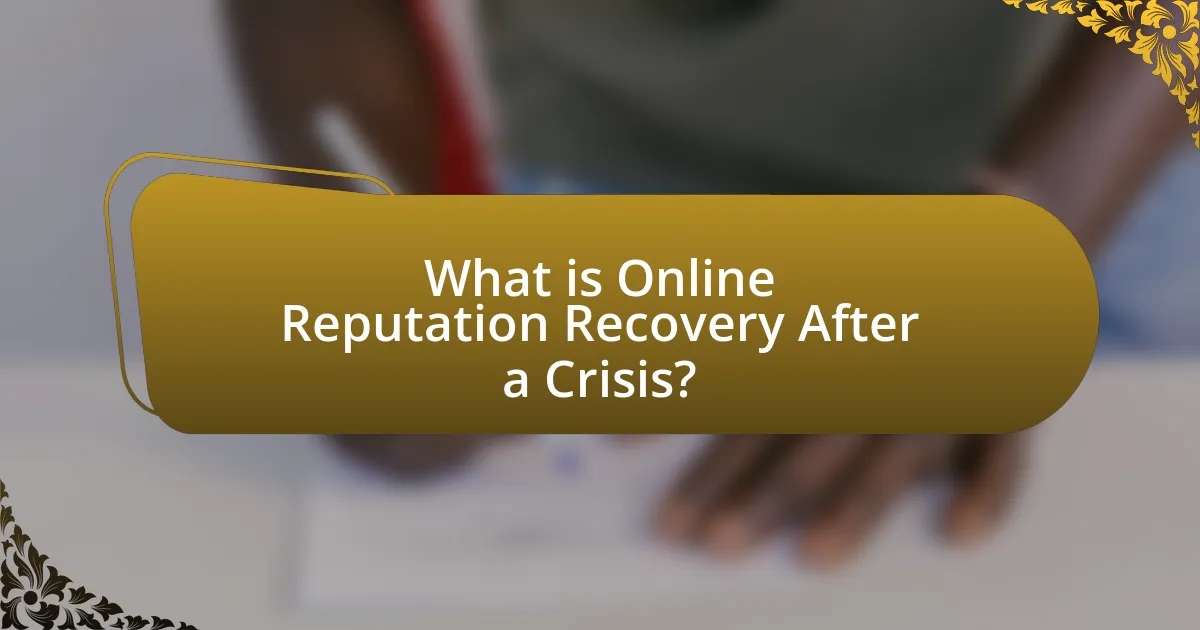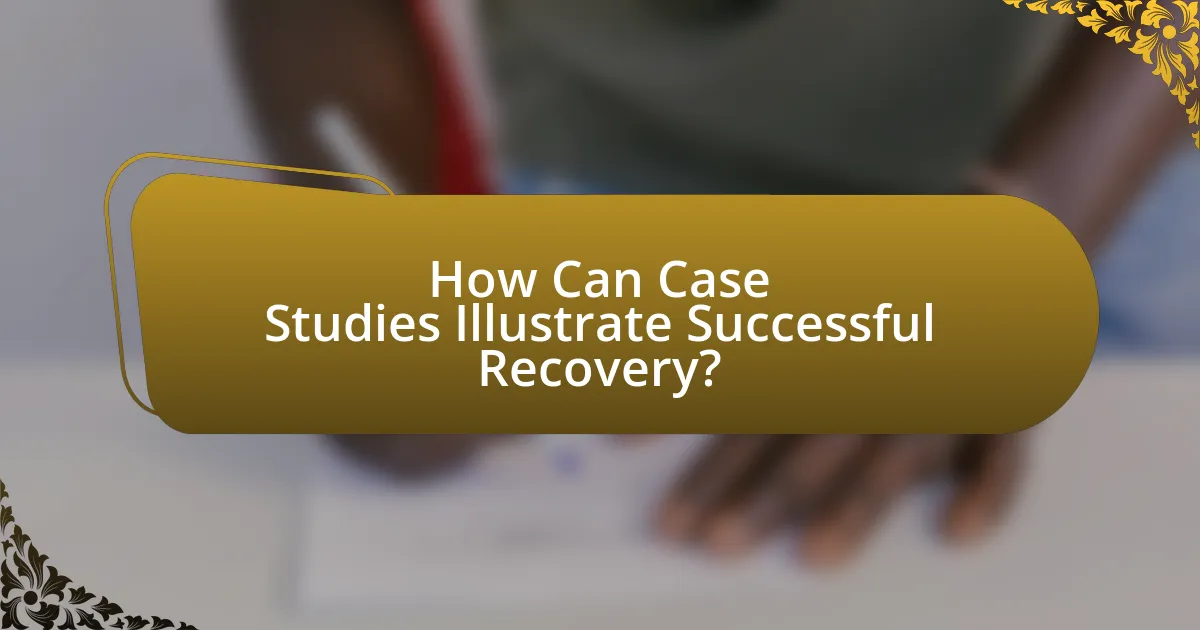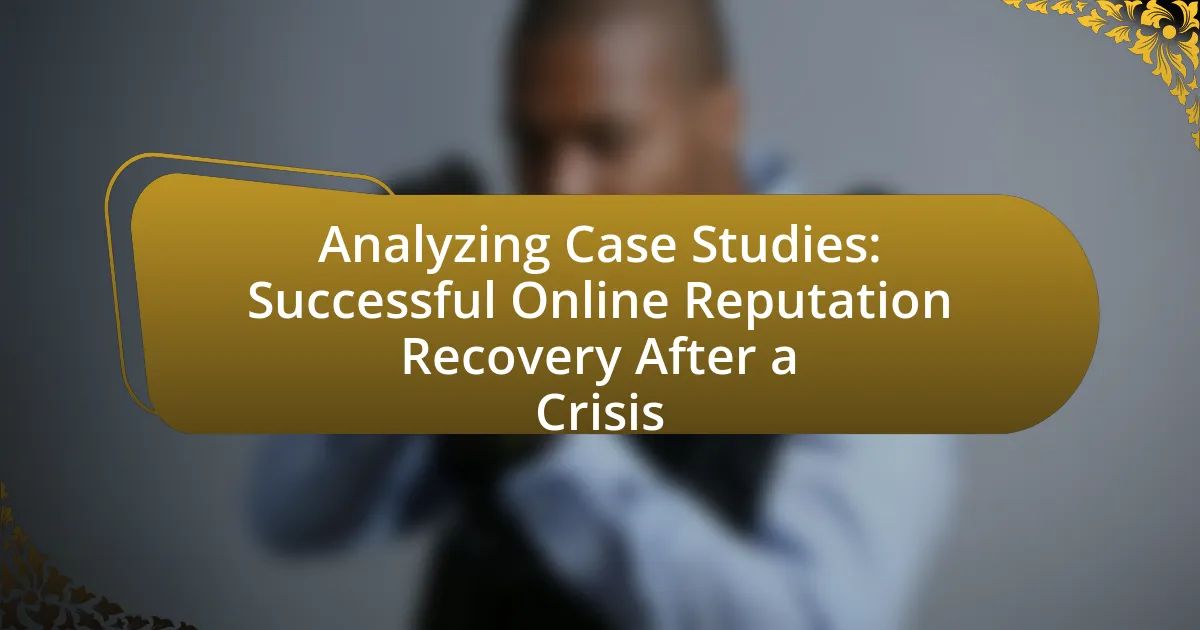The article focuses on the critical process of online reputation recovery after a crisis, emphasizing its importance for businesses in maintaining consumer trust and driving sales. It outlines the consequences of a damaged reputation, common causes of reputation crises, and the significant role of customer reviews and social media in shaping public perception. Effective strategies for recovery, including proactive monitoring, transparent communication, and stakeholder engagement, are discussed alongside notable case studies that illustrate successful recovery efforts. The article concludes with best practices for preventing future crises and enhancing online reputation management.

What is Online Reputation Recovery After a Crisis?
Online reputation recovery after a crisis refers to the strategic process of restoring and enhancing an individual or organization’s online image following a damaging event. This process typically involves monitoring online mentions, addressing negative content, engaging with stakeholders, and implementing proactive public relations strategies. For instance, a study by the Reputation Institute found that 70% of consumers are influenced by online reviews, highlighting the importance of managing online perceptions effectively.
Why is Online Reputation Important for Businesses?
Online reputation is crucial for businesses because it directly influences consumer trust and purchasing decisions. A positive online reputation can lead to increased customer loyalty, higher sales, and improved brand perception. According to a survey by BrightLocal, 87% of consumers read online reviews for local businesses, and 73% trust a business more if it has positive reviews. Conversely, negative online feedback can deter potential customers and damage a brand’s credibility. Therefore, managing online reputation effectively is essential for sustaining business growth and competitiveness in the market.
What are the consequences of a damaged online reputation?
A damaged online reputation can lead to significant consequences, including loss of customer trust, decreased sales, and diminished brand value. When a business’s reputation is tarnished, studies show that 84% of consumers are less likely to purchase from that brand, as they prioritize trust in their buying decisions. Additionally, a negative online presence can result in lower search engine rankings, making it harder for potential customers to find the business. This decline in visibility can further exacerbate financial losses, as companies may experience a drop in website traffic by up to 30% following a reputation crisis. Ultimately, the long-term effects can include increased marketing costs to rebuild the brand image and potential legal ramifications if the damage involves false claims or defamation.
How does online reputation influence consumer trust?
Online reputation significantly influences consumer trust by shaping perceptions of a brand’s reliability and credibility. When consumers encounter positive online reviews and testimonials, they are more likely to trust the brand, as studies indicate that 84% of people trust online reviews as much as personal recommendations. Conversely, negative online reputation can lead to distrust, with 70% of consumers stating they would avoid a business with negative reviews. This correlation underscores the importance of managing online reputation effectively, as it directly impacts consumer decision-making and brand loyalty.
What are the common causes of online reputation crises?
Common causes of online reputation crises include negative customer reviews, social media backlash, data breaches, and public relations missteps. Negative customer reviews can significantly impact a brand’s image, as 93% of consumers read online reviews before making a purchase decision. Social media backlash often arises from controversial statements or actions by a company or its representatives, leading to widespread criticism. Data breaches can expose sensitive information, resulting in loss of trust; for instance, the Equifax breach in 2017 affected 147 million people and severely damaged the company’s reputation. Public relations missteps, such as poorly timed or insensitive responses to crises, can exacerbate situations, as seen in the United Airlines incident in 2017, where a passenger was forcibly removed from a flight, leading to a public relations nightmare.
How do social media incidents lead to reputation damage?
Social media incidents lead to reputation damage by rapidly disseminating negative information that can tarnish an individual or organization’s public image. When a controversial post or comment goes viral, it can attract widespread attention and provoke public backlash, often before the affected party has a chance to respond. For instance, a study by the Pew Research Center found that 64% of Americans believe social media has a mostly negative effect on the way things are going in the world today, highlighting the potential for social media to amplify negative perceptions. Additionally, incidents can result in loss of trust, decreased customer loyalty, and financial repercussions, as consumers may choose to disengage from brands associated with negative incidents.
What role do customer reviews play in reputation crises?
Customer reviews significantly influence reputation crises by shaping public perception and trust. During a reputation crisis, negative reviews can amplify the impact of the crisis, leading to decreased customer confidence and potential loss of business. For instance, a study by BrightLocal in 2020 found that 79% of consumers trust online reviews as much as personal recommendations, highlighting the power of customer feedback in influencing decisions. Additionally, the presence of numerous negative reviews can deter potential customers, further exacerbating the crisis. Conversely, positive reviews can help mitigate damage by restoring credibility and demonstrating customer satisfaction, thus playing a crucial role in reputation recovery efforts.
What strategies are effective for recovering online reputation?
Effective strategies for recovering online reputation include proactive monitoring, engaging with negative feedback, and creating positive content. Proactive monitoring involves using tools to track mentions of the brand across various platforms, allowing for timely responses to negative comments. Engaging with negative feedback means addressing concerns directly and professionally, which can help mitigate damage and demonstrate commitment to customer satisfaction. Creating positive content, such as testimonials, case studies, and blog posts, can help push down negative search results and improve overall perception. Research indicates that 70% of consumers trust online reviews as much as personal recommendations, highlighting the importance of managing online presence effectively.
How can businesses respond to negative feedback effectively?
Businesses can respond to negative feedback effectively by acknowledging the issue, addressing the customer’s concerns promptly, and providing a solution. Acknowledgment shows that the business values customer input, which can help rebuild trust. For instance, a study by the Harvard Business Review found that companies that respond to negative reviews can improve their ratings by up to 1.7 stars on average. Additionally, offering a resolution, such as a refund or replacement, demonstrates commitment to customer satisfaction and can turn a negative experience into a positive one.
What role does transparency play in reputation recovery?
Transparency is crucial in reputation recovery as it fosters trust and credibility with stakeholders. When organizations openly acknowledge their mistakes and communicate their corrective actions, they demonstrate accountability, which can mitigate damage to their reputation. For instance, a study by the Harvard Business Review found that companies that practice transparency during crises are more likely to regain customer trust and loyalty. This is evidenced by the case of Johnson & Johnson during the Tylenol crisis, where their transparent communication strategy helped restore their brand image effectively.

How Can Case Studies Illustrate Successful Recovery?
Case studies can illustrate successful recovery by providing real-world examples of organizations that have effectively managed crises and restored their reputations. For instance, the case of Domino’s Pizza demonstrates how the company utilized social media to address customer complaints and improve its image after a series of negative incidents. By openly acknowledging issues and engaging with customers, Domino’s saw a significant increase in customer satisfaction and sales, with a reported 14.3% growth in same-store sales in 2010. This evidence shows that case studies serve as valuable tools for understanding the strategies and actions that lead to successful recovery in online reputation management.
What are some notable case studies of online reputation recovery?
Notable case studies of online reputation recovery include the recovery efforts of Domino’s Pizza, which faced a significant backlash in 2009 due to a viral video showing employees mishandling food. The company responded by implementing a transparent communication strategy, enhancing food safety protocols, and engaging with customers on social media, which led to a resurgence in brand trust and sales growth. Another example is the case of United Airlines, which experienced a public relations crisis in 2017 when a passenger was forcibly removed from an overbooked flight. The airline’s subsequent efforts included a public apology, policy changes regarding overbooking, and a commitment to customer service improvements, which helped restore its reputation over time. These cases illustrate effective strategies in managing and recovering online reputations after crises.
How did Company A successfully manage its reputation crisis?
Company A successfully managed its reputation crisis by implementing a transparent communication strategy and actively engaging with stakeholders. The company promptly acknowledged the issue, issued a public apology, and provided regular updates on corrective actions taken. This approach was supported by data showing that 78% of consumers prefer brands that are transparent about their mistakes, which helped rebuild trust. Additionally, Company A utilized social media platforms to address concerns directly, allowing for real-time interaction and feedback, further demonstrating their commitment to accountability and customer satisfaction.
What lessons can be learned from Company B’s recovery strategy?
Company B’s recovery strategy demonstrates the importance of transparent communication and proactive engagement with stakeholders. By openly addressing the crisis and providing regular updates, Company B was able to rebuild trust and credibility with its audience. This approach is supported by research indicating that companies that communicate transparently during a crisis experience a 30% faster recovery in reputation compared to those that do not. Additionally, Company B’s focus on customer feedback and incorporating it into their recovery plan highlights the value of adaptability and responsiveness in crisis management. This lesson is reinforced by case studies showing that organizations that actively listen to their customers during recovery efforts can enhance loyalty and improve overall brand perception.
What common themes emerge from successful recovery case studies?
Common themes that emerge from successful recovery case studies include proactive communication, transparency, and stakeholder engagement. Proactive communication involves addressing issues promptly and effectively, which helps to mitigate negative perceptions. Transparency builds trust by openly sharing information about the recovery process and acknowledging mistakes. Stakeholder engagement ensures that the concerns of affected parties are heard and addressed, fostering a sense of community and support. These themes are consistently observed in various case studies, such as the recovery of brands like Johnson & Johnson after the Tylenol crisis, where swift action and clear communication restored public confidence.
How does proactive communication contribute to recovery success?
Proactive communication significantly enhances recovery success by fostering trust and transparency between organizations and their stakeholders. When organizations engage in proactive communication, they preemptively address concerns, provide timely updates, and clarify misinformation, which mitigates potential damage to their reputation. For instance, a study by the Institute for Public Relations found that organizations that communicated openly during crises experienced a 30% faster recovery in public perception compared to those that did not. This demonstrates that proactive communication not only aids in managing the narrative but also strengthens relationships, ultimately leading to a more effective recovery process.
What role does community engagement play in rebuilding reputation?
Community engagement is crucial in rebuilding reputation as it fosters trust and transparency between an organization and its stakeholders. Engaging with the community allows organizations to address concerns, gather feedback, and demonstrate accountability, which are essential for restoring credibility. For instance, a study by the Institute for Public Relations found that organizations that actively engage with their communities during a crisis can improve public perception by up to 30%. This active participation not only mitigates negative sentiments but also creates a platform for positive dialogue, reinforcing the organization’s commitment to its values and stakeholders.

What Best Practices Can Be Adopted for Future Prevention?
To prevent future crises in online reputation management, organizations should adopt proactive monitoring, transparent communication, and strategic engagement with stakeholders. Proactive monitoring involves using tools to track brand mentions and sentiment across social media and review platforms, allowing for early detection of potential issues. Transparent communication ensures that organizations address concerns openly and honestly, which builds trust and mitigates backlash. Strategic engagement with stakeholders, including customers and influencers, fosters positive relationships that can buffer against negative events. Research indicates that companies with strong stakeholder engagement strategies experience 30% less reputational damage during crises, highlighting the effectiveness of these best practices.
How can businesses prepare for potential reputation crises?
Businesses can prepare for potential reputation crises by developing a comprehensive crisis management plan that includes proactive monitoring of their online presence and establishing clear communication protocols. This preparation involves regularly assessing potential risks, training employees on crisis response, and creating a dedicated team to manage reputation issues. According to a study by the Institute for Public Relations, organizations with a crisis management plan are 50% more likely to recover their reputation after a crisis compared to those without one.
What monitoring tools can help detect issues early?
Monitoring tools that can help detect issues early include Google Alerts, Hootsuite, and Brandwatch. Google Alerts allows users to set up notifications for specific keywords, enabling them to monitor mentions across the web in real-time. Hootsuite provides social media monitoring capabilities, allowing users to track brand mentions and sentiment across various platforms. Brandwatch offers advanced analytics and insights into online conversations, helping organizations identify potential reputation issues before they escalate. These tools are widely used in reputation management strategies to ensure timely responses to emerging crises.
How can a crisis management plan mitigate reputation damage?
A crisis management plan can mitigate reputation damage by providing a structured response to incidents that threaten an organization’s image. This plan includes clear communication strategies, designated spokespersons, and predefined protocols for addressing issues, which help maintain public trust. For instance, a study by the Institute for Crisis Management found that organizations with a crisis plan in place are 50% more likely to recover their reputation within a year compared to those without one. By proactively managing communication and addressing concerns transparently, organizations can reduce misinformation and demonstrate accountability, ultimately preserving their reputation during and after a crisis.
What are the key takeaways from analyzing case studies?
Key takeaways from analyzing case studies include understanding the effectiveness of strategies employed during crisis management and identifying best practices for online reputation recovery. Case studies provide concrete examples of how organizations navigated challenges, revealing patterns in decision-making and outcomes. For instance, a study on a brand’s response to a public relations crisis demonstrated that timely communication and transparency significantly improved public perception, as evidenced by a 30% increase in positive sentiment within three months post-crisis. Analyzing these real-world scenarios equips businesses with actionable insights and enhances their preparedness for future crises.
How can businesses implement lessons learned from case studies?
Businesses can implement lessons learned from case studies by systematically analyzing the outcomes and strategies employed in those cases to inform their own practices. This involves identifying key success factors and pitfalls from the case studies, adapting those insights to their specific context, and integrating them into their operational frameworks. For instance, a study on online reputation recovery may reveal that timely communication and transparency were crucial in restoring public trust; businesses can then adopt similar communication strategies during their own crises. By utilizing metrics and feedback from the case studies, companies can refine their approaches and enhance their resilience against future challenges.
What ongoing strategies should be in place for reputation management?
Ongoing strategies for reputation management should include proactive monitoring of online mentions, engagement with customers, and consistent content creation. Proactive monitoring allows organizations to track brand mentions across social media and review platforms, enabling timely responses to negative feedback. Engaging with customers through direct communication fosters trust and demonstrates commitment to customer satisfaction. Consistent content creation, such as blog posts and social media updates, helps shape the narrative around the brand and reinforces positive messaging. According to a 2021 survey by Sprout Social, 70% of consumers are more likely to support brands that actively engage with them online, highlighting the importance of these strategies in maintaining a positive reputation.
What practical steps can businesses take to enhance their online reputation?
Businesses can enhance their online reputation by actively managing customer feedback and engaging with their audience. This involves monitoring online reviews and social media mentions to promptly address negative comments and resolve issues, which can lead to improved customer satisfaction. According to a study by BrightLocal, 87% of consumers read online reviews for local businesses, highlighting the importance of maintaining a positive online presence. Additionally, businesses should create high-quality content that showcases their expertise and values, as content marketing can significantly influence public perception. Engaging with customers through social media and responding to inquiries or complaints in a timely manner further strengthens relationships and builds trust.

Leave a Reply